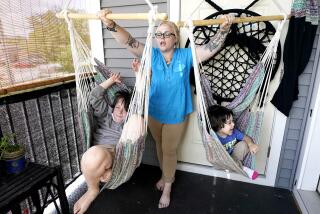PERSPECTIVES ON HOUSTON SUMMIT : Credit and Ingenuity Can Save the Children : Economists should be focusing on self-reliance development programs for the world’s poorest people.
- Share via
DHAKA, Bangladesh — Economic growth and cooperation will be the main agenda items for the leaders of seven industrialized countries meeting in Houston. But one more matter deserves their attention: the very achievable goal of eliminating poverty in which children are condemned to grow in all countries.
I came across children’s issues as an economic matter only recently. When I was studying economics in the United States, I was not encouraged or required to pay attention to the condition of children in any society, rich or poor. In the economics literature, there is no category called “children.” There isn’t even any mention of men or women. “Labor” is the nearest thing to “people” that one comes across in economics literature.
I became a drop-out from economics after returning to Bangladesh in 1972, when I saw a horrible famine that provoked me to leave textbook economics behind and learn economics from the real lives of the poor. I quickly learned that poor people are much more capable of taking care of themselves than is portrayed in text books. I saw that they had a desperate need for credit, and so I reread the literature on banking.
Dissatisfied, I set myself on the task of demonstrating that credit is a much more powerful socioeconomic instrument than the literature held--that banking does not have to become exclusively dependent on collateral, and that credit is so basic as to be considered a fundamental human right.
It worked. It continues to work after 14 years of uninterrupted expansion. We have set up a formal bank, called Grameen (Rural) Bank, owned by the poor people. Now it lends to more than 700,000 of the poorest women in Bangladesh. The average loan is $67, and the repayment rate is over 98%.
Our program is being imitated in a growing number of countries throughout the world, including the United States.
We have demonstrated that credit to the poor can create self-employment and income. Men, women and children all can benefit from credit. But we have made it a policy to give priority to women. We also involve children. We did not do so from any emotional or moral compulsion. We saw very strong economic reasons for it, as we wanted to prepare the next generation to peel off all signs of poverty and instill in them a sense of human dignity and hope for the future.
With so much dramatic change going on in the world, we must hope that the so-called Group of Seven leaders will play a role in breaking the spell of conventional economic thinking. In the 1990s, a program addressed to children should not be looked at as a humanitarian program; it should be given the status of a prime economic development program.
A “children first” strategy, so well promoted by UNICEF, must be focused on the human being, not on any physical accumulations and achievements. We should discard or modify institutions that restrict people’s initiative and enterprise and create institutions that help people reach their potential. In doing so, our attention should be on people at the bottom, people in the poorest 50% of the population, with special emphasis on the poorest 20%.
Increased emphasis must be given to creating democratic self-government institutions at the local or village level. And we must resist giveaways and handouts of all kinds. Communities must be charged “prices” for receiving resources, with the funds thus mobilized invested for future, self-reliant development in that same locality.
The essence of this strategy must be to have every community mobilize all the human ingenuity at its disposal to ensure that no child born into poverty passes that stigma to the next generation.
In short, for the 1990s the key formula is: right to life with dignity for all children; income for women; institutions to help release potential capabilities of the poor, democracy at the local level and no handouts.
That’s a tough agenda. But if the leaders will get serious about ending the intolerable situation of 40,000 children dying every single day, it is an agenda they cannot avoid. In the context of the resources being freed up at the conclusion of the Cold War era, the G-7 leaders and those who will attend the World Summit for Children in September can afford to adopt such an agenda and commit themselves to achieving the end of child poverty within a decade.
More to Read
Sign up for Essential California
The most important California stories and recommendations in your inbox every morning.
You may occasionally receive promotional content from the Los Angeles Times.










